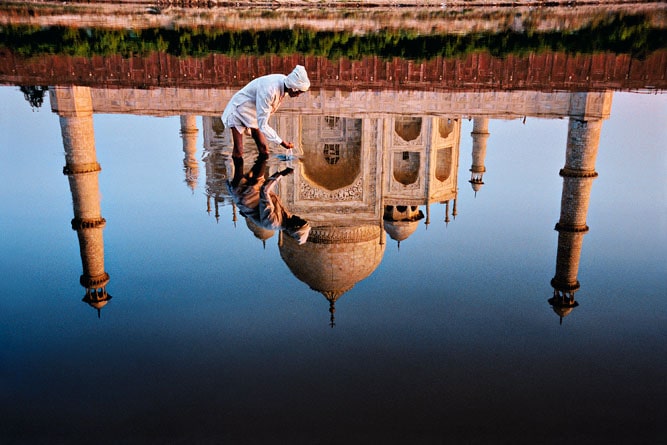Taj Mahal
Historical monument in Agra
must-see attraction
Opening hours: dawn-dusk Saturday-Thursday (closed on Friday)
Address: Dharmapuri, Forest Colony, Tajganj, Agra
Ticket price: Indian/foreigner ₹50/1100, mausoleum ₹200, video ₹25
Visit duration: People typically spend 2 to 3 hours here
Website: www.tajmahal.gov.in
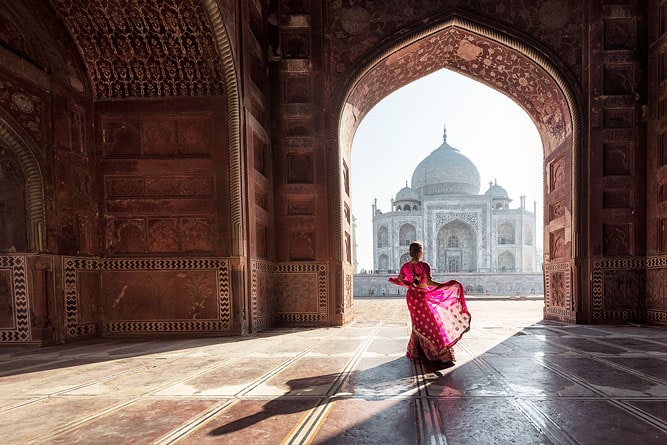
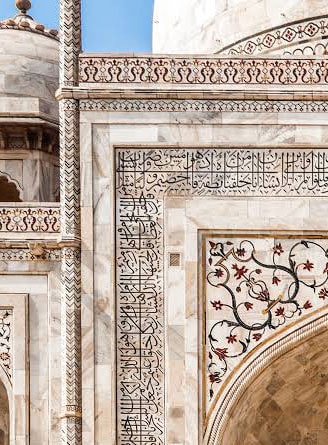
About the Taj Mahal, Agra
Admired for its timeless beauty by poets belonging to different eras and areas, the Taj Mahal is a must-see attraction located in Agra, on the banks of river Yamuna.
Described as ‘a teardrop on the cheek of eternity’ by Rabindranath Tagore, this magnificent, ivory-white mausoleum stands as a symbol of transient life that is made eternal with love.
The impressive and enormous complex was built in white marble between 1631 and 1648. UNESCO announced the Taj Mahal as a World Heritage Site in 1983 and it was enlisted among the Seven Wonders of the World in 2007.
Out of all the amazing tourist attractions in North India, the Taj Mahal surpasses all with its unparalleled history and royal Mughal architecture.
History of the Taj Mahal
Symbolising the perfect amalgamation of the extreme emotions of passion, love and grief, the Taj Mahal narrates the story of a heartbroken Mughal Emperor, Shah Jahan, who wanted to immortalise his love for his queen, Mumtaz Mahal.
You could say it is ironic that Mumtaz, for whom the Taj Mahal was constructed, was Shah Jahan’s third wife who died during the birth of their 14th child. However, the splendour of the building is such that one only remembers the love and the effort to immortalise their story.
Even to this day, tourists from all over the world visit the Taj Mahal. Even for people who have seen the picturesque Mughal monument in books and on screen, gazing at its beauty in real life is worth experiencing at least once.
While taking a tour of the Taj Mahal, keep your ears open for some interesting myths! One of the most popular myths portrays Shah Jahan as the brutal emperor who ordered for the hands of the construction workers to be chopped off, after looking at the magnificent structure they had built. Rumour has it that he was so in awe of the beautiful palace and did not want anyone else to replicate it!
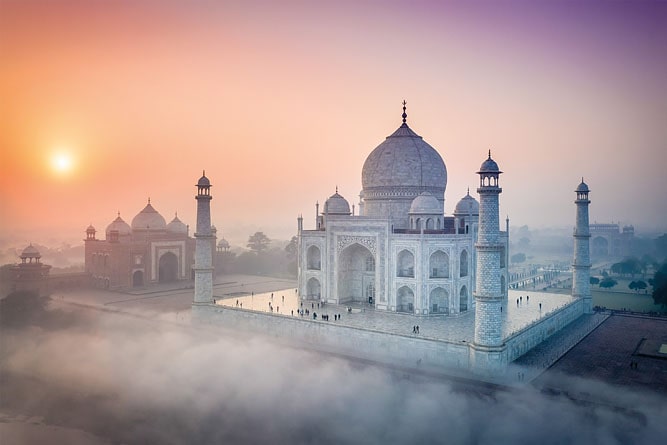
Inside the Taj Mahal
Located on the southern right bank of the Yamuna river, the Taj Mahal occupies 17-hectare (42-acre) of land in Agra. The monument is a conglomeration of Persian and Indian architecture with the touch of a regal aura. The entire structure took 22 years to build. The construction started in 1632. More than 20,000 workers from Persia, the Ottoman Empire and Europe came to India to build the mausoleum.
The structure consists of four minarets and gardens that mark the outset boundary of the building, a mosque, a mausoleum and jawāb, which translates to “answer”, a building mirroring the mosque and the main gateway.
The tomb of the queen is the principal structure which is enclosed by a marble-shaped tomb. The tomb has asymmetrical lotus carved on its marble walls. The columns open up at the roof which brings forth the light inside the tomb. There are 4 small tombs each situated at the corner to emphasise the actual tomb.
The exterior walls of the Taj Mahal are decorated with stucco, stone inlays, paint and carvings. The patterns of the carvings can be grouped as calligraphy, abstract art which is accompanied by inscriptions of verses from the Quran.
The marble walls of the tomb were infused with around 40 different kinds of stones like lapis lazuli, pearls, sapphire, emerald, diamonds, gold and rubies. The Taj Mahal is surrounded by gardens which are divided into four parts by shallow channels of water that mirror the image of paradise on the grounds of the earth.
Many of the precious stones are in time but their absence did not hamper the beauty of the Taj Mahal. It is indeed a fairyland found in the mundane world.
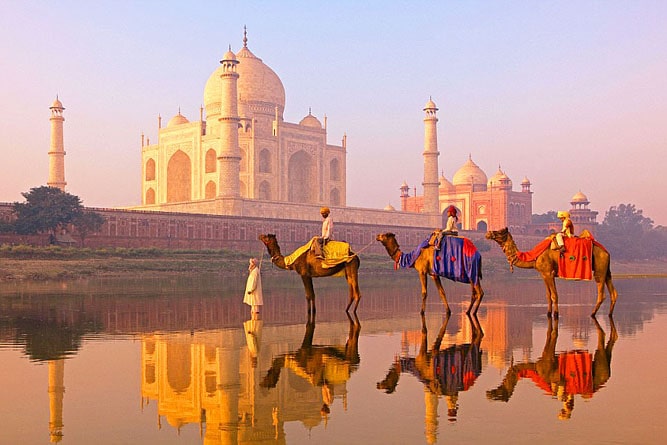
Entry fee and timings
The entry ticket costs ₹50 for Indians and ₹1100 for foreign visitors. Entry to the Mausoleum costs ₹200. The cost of video recording is ₹25 though you will not be allowed to click photographs or videos inside the main mausoleum.
The historical sight opens 30 minutes before sunrise and closes 30 minutes before sunset. The facility sightseeing stays closed on Fridays for the Taj Mahal.
Entry to the premise is available from the Eastern Gate of the Taj Mahal and western sides, the Western Gate near Saheli Burj of the Taj Mahal. The southern gate of the Taj Mahal only allows departure from the monument.
Facts and tips about the Taj Mahal
- The stones that were used to decorate the Taj Mahal were exported from different places in Asia like China, Tibet and Sri Lanka, along with different parts of India.
- The four pillars were designed to tilt in the opposite direction of the tomb so that the tomb does not get destroyed in case of any natural calamities like earthquakes.
- The lead architect of the Taj Mahal, Ustad Ahmad Lahauri was also the architect of the Red Fort.
- Since the Taj Mahal opens before sunrise, there is a queue to watch the sunrise from within the premise of the Taj Mahal. However, the early morning hours are the least crowded and you should aim to visit in the morning keeping a few hours in hand.
- Shoes are not allowed at the Taj Mahal, so you have to buy a shoe cover (a white cloth to cover the shoes), that way you do not have to walk barefoot in the Taj Mahal.
- If you show the entry ticket to the Taj Mahal during your visit to Agra Fort and other famous tourist attractions in Agra, then you can get a nominal discount while purchasing entry tickets to those places.
How to reach the Taj Mahal
The Taj Mahal is located in the city of Agra, on the west bank of the Yamuna River. The Agra Fort, the other main highlight of Agra, is a 5-minute drive away.
See location on Google Maps
Other attractions near the Taj Mahal
- Agra Fort - 2.6 km
- Itimad-ud-Daulah (Baby Taj) - 5.8 km
- Akbar's Tomb (Sikandra) - 14 km
FAQs about the Taj Mahal
1. Is it true that Shah Jahan chopped off the thumbs of the builders of the Taj Mahal?
No, it is a myth. The architect of the Taj Mahal was also one of the main architects involved in the construction of Agra Fort so this is a myth spread vastly across the world.
2. Is it true that the British Empire looted the Taj Mahal?
Yes, during the revolt of 1857, the British soldiers defaced the monument and chiselled precious stones from the walls.
3. What is the procedure to visit the Taj Mahal at night?
Tickets are available at the office of the Archeological Survey of India, Agra. Night viewing of thje Taj Mahal is possible from 8:30 pm to 12:30 at night. The duration of sight is 30 minutes per batch. The maximum capacity of viewers is 8 batches. Each batch has a limit of 50 people. The service is available for only 5 days per month, the day of the full moon and 2 days before and after the full moon.
4.Can we carry food for the picnic in the Taj Mahal?
No, carrying food inside is not allowed. You can’t even carry water or pens, cigarettes and lighters inside the mausoleum. Your entry ticket to the Taj Mahal entitles you to 500 ml of mineral water. Do take it.
